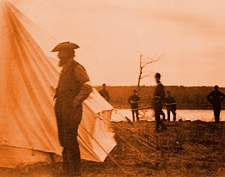
Note: Over the years that I've maintained the Famous Trials website, I have received a number of emails from Canadian visitors suggesting that I add the trial of Louis Riel. Like most Americans, I had never heard of the trial of Louis Riel. (We Americans tend to be remarkably ignorant about the history of our friendly neighbor to the north.) After doing some preliminary research, however, I came to the conclusion that the trial did merit coverage on the site--and not just because Louis Riel, at the time he is hanged in Regina, was an American citizen. The trial deserves coverage in part because of its large symbolic importance to Canadians, in part because of how the story of Louis Riel shaped the history of North America, and in part because of the lingering questions about Riel's mental state at the time of his participation in the North-West Rebellion of 1885. American readers of this trial might also note striking parallels between the Riel trial and the treason trial of Aaron Burr.
By modern standards, the North-West Rebellion, which Louis Riel led, seems no big deal. Canadian forces easily quelled the uprising of a couple of hundred Metis settlers along the South Saskatchewan River. A majority of Metis in the region sat out the fighting, and only about one hundred persons died in the conflict. (Although that figure of one hundred deaths was significant in this sparsely populated region.)
The importance of the North-West Rebellion, apart from establishing the ability of the Canadian government to successfully carry out a military action far from its center of power, is symbolic. As has been often noted by historians, the debate over the North-West Rebellion and the subsequent trial of Louis Riel reveals the tensions that continue to distinguish Canada: east versus west, native versus non-native, French-speaking versus English-speaking, American versus Canadian. Over time, Louis Riel has been seen as "a demagogic madman," as an innocent victim of Prime Minister John Macdonald's fanaticism, or as a martyred national-liberation leader. None of these characterizations is entirely accurate; each contains some measure of truth. The North-West Rebellion and the trial of Louis Riel is best understood as the product of a particular place and time: the Canadian frontier, in a time when civilization and its institutions confronted the traditions of a more primitive people.
The North-West Rebellion had its roots in an earlier crisis. In March 1869, The Hudson's Bay Company owner of a large swath of land called Rupert's Land (including present-day Manitoba and Saskatchewan), agreed to sell most of its land to the Canadian Government in return for 300,000 pounds in cash and land grants totaling seven million acres. Before the transfer became effective on December 1, decisions had to be made what to do with the 12,000 settlers living in the Red River area of Rupert's Land, near present-day Winnipeg. About four-fifths of these settlers were Metis, persons of mixed white (usually French) and Indian ancestry.
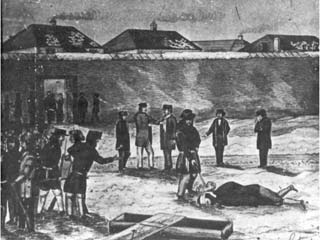
The execution of Thomas Scott
Who was Louis Riel? Riel might be the most complicated, elusive, puzzling, and controversial figure in Canadian history. An examinaion of the chapter titles of Albert Braz's 2003 biography, The False Traitor: Louis Riel in Canadian Culture, suggests the many and disparate ways in which Riel has been seen: "The Red River Patriot," "The Traitor," "The Martyr," "The Go-Between," and "The Mystic/Madman."
Riel was born in 1844 into a devout Catholic family in St. Boniface, a settlement on the Red River, in present-day Winnipeg. Although of seven-eighths white ancestry, Riel considered himself a Metis. He left home at age fourteen to travel to Montreal and study for the priesthood. He proved himself to be a serious and gifted student, striking his masters as deeply faithful and scholarly, but some and a bit odd and reclusive. Two years later, when his widowed mother begged him to return home, Riel left Montreal. On his way back in 1868, Riel stayed for several months in St. Paul, where he heard stories from Metis traders of growing unrest in the settlements north of the border along the Red River.
The impending transfer of the Hudson Bay Company's land to Canada was a major worry for the Metis, who wondered what it might mean for the thier independent lifestyle. (And, of course, the native people who lived on the land might have beggged to differ about whether the land was really the King's to grant in 1670, when it first came to be owned by the Company.) No one in power seemed particularly interested about how the 10,000 or so Metis, and 2,000 or so white settlers, who lived along the Red River area of Rupert's Land felt about the transfer. When Riel returned to his mother's small cottage, he began to understand--then to champion--the cause of the Metis. The fact that Riel spoke English--a rare ability among the Metis--buttressed his influence.
When a Canadian survey team showed up in the Red River region in the fall of 1869, local residents concerns increased. Riel persuaded the surveyors to abandon their mission. Then he rallied the French-speaking Metis and the English-speaking mixed race people, stressing their common grievances with Eastern interests. He urged the creation of a local army to oppose the appointment of William McDougall as the new lieutenant-governor to run the Red River settlement.
Riel's message resonated and he took the offensive. Riel's rag-tag army seized Fort Garry, a fort on the Red River owned by the Hudson's Bay Company. The fort fell without bloodshed. Then Riel formed a provisional government with himself as the president. A plot by whites was set in motion to retake Fort Garry. But Riel's government got wind of it and arrested the plotters.
In March 1870, a provisional court court-martialed for treason, sentenced to death, and executed Thomas Scott, the hot-headed and most unrepentantly racist and uncooperative member of a group that had attempted to re-take Fort Garry from Riel's government. The decision to execute Scott came after he relentlessly taunted his captors.
Scott's killing, and the outrage it caused, became the "central and defining event of the Red River Resistance." Hope of compromise went out the window. When word of Scott's execution got out, many infuriated English-speaking Canadians in Ontario called for Riel's head. Prime Minister John Macdonald sent forces west to regain control of the region. Riel's provisional governmental army was no match for the Canadian troops. Riel fled just hours before the troops reached and re-took Fort Garry.
In June 1870, Canadian negotiators reached agreement with Riel's government to establish a new province to be called Manitoba. Settlers were promised the right to retain their land, and and additional 1.4 million acres within the province were pledged to be reserved for future Metis possession. When word, however, reached Riel that the amnesty he thought had been promised in the negotiations was not forthcoming, he fled to the Dakota Territory. With a $5,000 bounty on his head, Riel decided life might be better for a while in the United States.
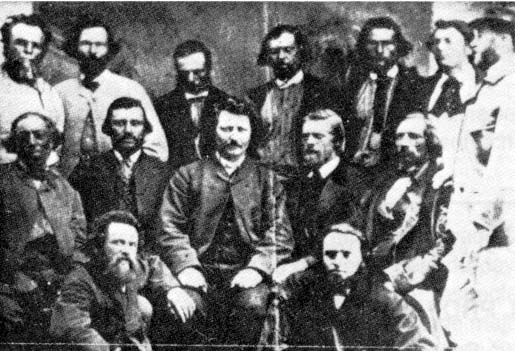
Riel with his 1870 Council
The next several years saw Riel go in and out of Canada, and in and out of the Canadian Parliament. For periods of time, he lived in Minnesota and in northern New York, but he remained committed to Metis politics. In October 1873, even with an outstanding warrant for his arrest, Riel won election to the Canadian Parliament. He traveled to Ottawa with plans to take his seat, but fearful of arrest and with a $5000 reward posted for his capture, he decided to return instead to the United States. In February 1874, Riel won the seat again, even though he was hiding in Montreal, far from his Red River home, at the time. Fellow legislators, calling him a "fugitive from justice," voted to expel Riel two months later, but that didn't stop Metis voters from giving him the unclaimed seat back for a third time in September. Tired of dealing with the Riel issue and anxious to put the 1869-70 problems behind them, legislators voted in 1875 to grant amnesty for participants in the Red River uprising--but in Riel's case the amnesty was conditioned on his agreeing to a five-year banishment from Canada.
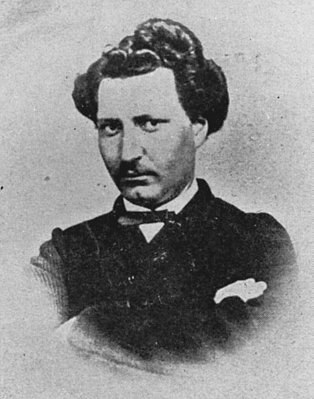
Louis Riel
Riel's banishment led to a turning point in his life. Shortly after meeting with President Grant in Washington to discuss the plight of his people in Canada, Riel claimed to have a vision in which God annointed him as his "prophet of the new world." No longr did Riel see himself as an exiled and failed political leader. He was now the voice for a people favored by God, the Metis.
Riel's vision raised questions about his mental health. So did many of his other actions. Riel proclaimed to some that he was the Biblical King David. He developed a propensity for ripping his clothes off, explaining that it was beautiful, as Adam and Eve did before the first sin, to be nude. Friends observed Riel crying and shouting in public. Ge gave $1000 to a blind beggar. He interrupted a mass to contradict a priest. These and other unusual claims and practices landed Riel in an asylum near Montreal in March 1876. At the asylum, Riel's mental condition continued to deteriorate. On one occasion, he smashed ornaments and candles in the asylum's chapel. Several times orderlies placed Riel in a strait-jacket. Riel remained at the asylum, under an assumed name, until February 1878.
Meanwhile, Manitoba was undergoing a rapid evolution. The province was becoming more English and less French. It grew more dependent on rail and steamboats, and less dependent on the old Red River carts. Its hunting and fur-trading economy was giving way to farming. Metis, intent upon preserving their traditional lifestyle looked west. Several thousand Metis migrated from Manitoba to lands near the Saskatchewan River.
Eventually, Riel's health improved enough to allow his discharge from the asylum in Montreal. He traveled through the northern U. S. and Manitoba before settling in Montana in late 1879. There, he found work as a trader selling goods to Indians and Metis at Fort Benton in the Missouri River country. His experience as a trader made Riel worry about the future of his race. In his letters, he expressed bitter disappointment with the "half-breed" who "spends most of his earnings on whiskey." Riel launched an effort to prohibit the sale of alcohol to Metis, but too many people benefited from the trade and the effort failed.
By the spring of 1883, Riel was married with two children, and was a new American citizen. His new job was a teaching position at the Catholic mission of St. Peter's on Montana's Sun River. Riel enjoyed teaching, but the job paid poorly and the work hours were too long to allow him to pursue his true interests in religion, poetry, and politics.
Back in Saskatchewan, things were not going well for the Metis. Following their custom, Metis settlers had claimed long, narrow lots, almost all with river footage. It allowed the Metis to cluster together in homes close to the riverfront. Problems arose when Canadian government surveyors working in the area, redrawing plots on which the Metis had settled. The surveyors employed the English system of square lots, plotted without regard to river access. When Gabriel Dumont requested the area be resurveyed to conform to Metis notions of workable lots, the Government Lands Office dismissed the idea, citing the great cost of conducting a second survey. In addition to complaints about the shape of lots, Metis expressed frustration over having to wait three or more years to receive title to land and argued that they were entitled to land grants similar to those provided in the Manitoba Act. Anger among the Metis simmered until the summer of 1884 when a delegation, led by Gabriel Dumont, traveled to St. Peter's Mission, Montana.
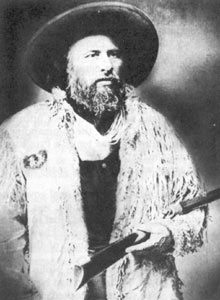
Gabriel Dumont
The reason for the delegation's visit to the United States was to recruit Louis Riel to assist them in their struggle with the Canadian government. Riel was not surprised when the knock came to his door. A month earlier, he had received a letter from Metis friends that said, "The whole race is calling on you." Riel responded to the call, and headed north to the small river town of Batoche.
By March 1885, after having found little success in petitioning Ottawa for a redress of grievances, Riel took the radical step of calling a meeting in a local church where he called for a vote on setting up a provisional government, which Riel called "the Exovedate" (from Latin, meaning "out of the flock"), and taking up arms against the Canadian government. He had another announcement as well. Riel said that he would establish a new church under a new pope, Bishop Bourget of Montreal. He assured followers that God will help the members of his flock as his new chosen people. Riel then performed a ritual in which he breathed the "Holy Spirit" into each person declaring support for his cause.
The first violence of the 1885 North-West Rebellion erupted on March 26 when a party led by Gabriel Dumont, on a mission to a general store by Duck Lake, encountered two mounties. The Metis rebels chased the mounties as they raced to rejoin a larger group of CMP. As Dumont and his band fired shots over their heads, the mounties retreated to Fort Carlton. More recruits joined the rebels in time for a second enounter with Mounties near Duck Lake. When the rebels met the mounties, the mounties drew their sleighs into a defensive circle. Two rebels approached the mounties under a white flag, but fighting erupted and the mounties shot both men. The killing of the two rebels led to a fire fight that left twelve mounties and five rebels dead, with others on both sides seriously wounded.
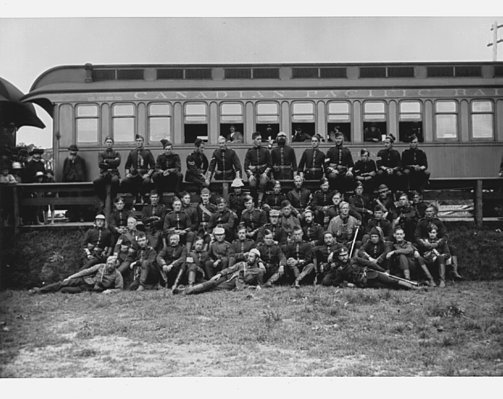
With casualties on both sides, Riel and the rebels had crossed a line. Whatever small hope there might have been to achieve compromise and concessions was gone. When word of the Duck Lake violence reached Prime Minister Macdonald, he ordered that 2,000 Canadian troops be sent west over the still-uncompleted rail lines of the Canadian Pacific. In 1885, there were still large gaps in the railroad between Toronto and the Canadian West. The troops sent by Macdonald traveled by foot and sleigh from one segment to another. (The crisis helped build support to finish the railroad line. Some people have even suggested that Macdonald's non-responsiveness to Metis complaints was part of a plot to build support for the project. Support the troops! Build the railroad! For people who buy this conspiracy theory, Riel died to save a railroad--a railroad that now stretches from sea to shining sea.)
By mid-April, the troops, led by Major-General Frederick Middleton, arrived in Qu'Appelle, 175 miles southeast of Batoche. The arrival of the troops came after a massacre of nine whites at Frog Lake earlier in the month had dramatically increased tensions in the area.
The troops encountered their first fighting on April 24 near Fish Creek, as Middleton was leading the men north toward Batoche. Dumont and about 200 rebels had hid above a ravine looking down on Fish Creek, hoping to ambush the Canadian soldiers. A scout foiled the plan when he spotted the rebels in the woods. Before long, the Canadian troops were commanding the higher ground firing down into the woods where the rebels had sought refuge. By the end of the day, six Canadian soldiers lay dead and another forty-nine wounded. The rebels lost four men--and forty-five horses.
The climactic battle between the badly-outnumbered rebels and Middleton's troops began on May 9 near Batoche. As a gunboat carrying troops steamed up the Saskatchewan River, other troops marched over land to the rebel-held town. Knowing the rebels were pinned down and low on ammunition, Middleton was content to led the fighting drag on for several days. By May 12, when it became apparent that the rebels ammunition was all but gone, the troops charged. Many rebels, including Riel, fled into the woods north of town in the face of the advancing troops. Three days later, understanding his cause to be hopeless and believing that a public trial might draw attention to the struggle of the Metis people for justice, Riel surrendered to Canadian troops. Meeting his enemy captive for the first time, Middleton described Riel as "a mild-spoken and mild-looking man, with a short brown beard and an uneasy frightened look about his eyes which gradually disappeared as I talked to him."
THE TRIAL
An escort of sixteen soldiers transported Riel to the police barracks at Regina. Inspector Richard Deane, concerned about a flood of journalists and Metis sympathizers showing up at his barracks, ordered that no one could visit Riel without a letter from the Prime Minister. He also ordered that Riel carry a ball and chain whenever he entered the barrack yard for fresh air or exercise. In the eight weeks before his trial, Riel occupied himself writing religious poetry, letters to relatives and friends, and notes about his religious and political movement.
On July 20, Riel plead "not guilty" to "wickedly, maliciously, and traitorously" making "war against our lady the Queen" and "maliciously and traitorously" attempting to "by force and arms subvert and destroy the constitution and government of this realm." Treason charges rested on the three battles with government forces: Duck Lake, Fish Creek, and Batoche.
Impressive teams of lawyers were assembled for both sides. A sixty-year-old Toronto barrister named Christopher Robinson led the prosecution for the Crown. The defense was headed by a thirty-five-year-old Quebec criminal attorney, Francois-Xavier Lemieux, who later would become the Chief Justice of Quebec. Ably assisting Lemieux was Charles Fitzpatrick, who later in his career would serve as Chief Justice of Canada.
Given their client's central role in the rebellion, defense lawyers had little choice but to adopt an insanity strategy. There was plenty of evidence showing Riel to be a psychologically troubled megalomaniac. Riel, after all, told anyone who would listen that he was the New World's prophet. The problem for the defense in an insanity case is proving to jurors that the defendant's mental condition was such that he could not appreciate the wrongfulness of his illegal conduct. While the government rounded up dozens of witnesses who could testify as to the instigating and central role Riel played in the uprising, defense lawyers Lemieux and Fitzpatrick began to identify religious leaders in Saskatchewan and medical experts elsewhere in Canada that might be able to offer compelling testimony in support of an insanity plea. The defense also prepared a long brief arguing that Canadian law did not allow a capital case to be decided by a mere six jurors, as plans called for.
On July 28, 1885, the trial began in a makeshift courtroom created in the rented offices of a Regina land company. After Judge Hugh Richardson rejected each of the contentions in the defense brief, including the argument based on the six-person jury, the prosecution opened its case. A series of government witnesses described Riel's responsibility for events in the ill-fated rebellion. John Willoughby testified concerning Riel's vision of a new government of god-fearing citizens. Thomas McKay told jurors that Riel described the Hudson's Bay Company and the Canadian government as "curses" and urged that arms be taken up. George Ness testified that Riel claimed a power to predict the future and announced that "Rome had tumbled." Thomas Jackson told of Riel giving fighting orders. The defense generally limited its cross-examination to questions designed to elicit an admission that Riel was behaving strangely.
The prosecution's star witness was Charles Nolin, cousin of Riel and formerly one of his closest associates. Nolin testified that Riel hoped to sow the seeds that would eventually break Canada into a number of separate countries, each governed by a distinct ethnic group. Riel, who had been sitting passively through testimony by the previous prosecution witnesses, became agitated during Nolin's examination and leaped to his feet, asking that he be given the opportunity to put questions directly to Nolin. Riel's attorney, Charles Fitzpatrick, asked the court not to allow questioning by his client, fearing perhaps that it would undermine his insanity defense. Riel's response made it clear that the insanity defense was not one of his choosing: "If you will allow me, Your Honor, this case comes to be extraordinary, and while the Crown, with the great talents they have at its service, are trying to show that I am guilty--of course it is their duty--my counselors are trying--my good friends and lawyers who have been sent here by friends I respect, are trying to show that I am insane." An argument between Riel and Fitzpatrick ensued, ending only when Judge Richardson explained to Riel that the consequence of his asserting his right to cross-examine Nolin would, in this case, be the loss of services of his lawyers for all aspects of the case.
The defense began its case on the third day of the trial. Father Alexis Andre and Father Fourmond testified about Riel's peculiar visions and religious beliefs. They indicated that they both thought him mad. Questions to the priests concerning the reasons for Metis dissatisfaction with Ottawa met with objections from the government, who argued successfully that such complaints did not excuse armed action and were therefore not relevant to the issue of guilt in a treason trial. The defense closed its case by calling two expert medical witnesses, Dr. Francois Roy and Dr. Daniel Clark. Roy, superintendent of the notorious Beauport asylum near Montreal, where Riel spent nearly two years as an inmate, testified that Riel suffered from "megalomania" and was clearly of an unsound mind. Dr. Clark, superintendent of the more-respected Toronto asylum and future president of the American Psychiatric Association, told the jury that he considered that Riel had been insane ever since 1865, when he wrote a letter suggesting that he was not really Louis Riel, but a Jew. Testimony ended with the calling of rebuttal witnesses by the prosecution, each of whom recounted conversations with Riel that convinced them that he was not insane.
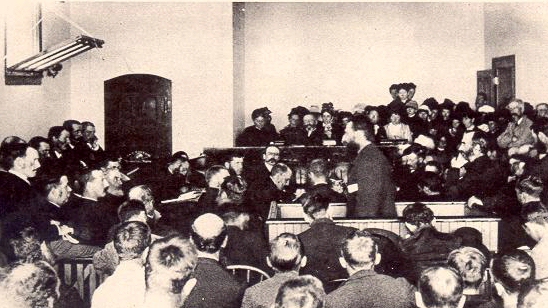
Riel addresses his jury
Closing arguments in the case of Queen v Louis Riel stand among the most eloquent ever delivered in a Canadian courtroom. Charles Fitzpatrick, for the defense, began his presentation with a short history of the conflict, offering both praise to the young volunteers who headed west to put down the rebellion and sympathy for the Metis and the grievances they felt with the Canadian government. Mostly, however, Fitzpatrick laid out the evidence of Riel's lunacy which, he argued, removed from him moral responsibility for his actions. Riel followed Fitzpatrick, offering--over the disclaimers of responsibility for his statements by his own attorneys--a political statement of the grievances of his people. In Riel's version of events, armed rebellion became an act of self-defense and treason, if there was any, was on the part of the government. Riel, working hard to find the right English words for his story, spoke for over an hour until Judge Richardson interrupted to ask, "Are you done?" A few minutes later, he was. Christopher Robinson closed for the Crown. Robinson argued the evidence of Riel's guilt was overwhelming. He emphasized Nolin's testimony that Riel would have abandoned his cause and returned to Montana had the government only been willing to pay him a $35,000 bribe to do so--not the sort of decision a visionary madman would make.
The jury of six men deliberated Riel's fate for an hour. They filed back into the courtroom. The foreman, Francis Cosgrove, "crying like a baby" announced the verdict. "Guilty," he said, and then added, "Your Honor, I have been asked by my brother jurors to recommend the prisoner to the mercy of the Crown." Later, one of the jurors would write a letter to a member of Parliament expressing his mixed feelings about the verdict he helped render: "Had the Government done their duty and redressed the grievances of the half-breeds of Saskatchewan...there would never have been a second Riel Rebellion, and consequently no prisoner to try and condemn."
Judge Richardson, however, was not in a merciful mood. He declared that Riel had "let loose the floodgates of rapine and bloodshed." He found "no excuse whatever" for his treason and sentenced Riel to "be hanged by the neck 'til you are dead."
TRIAL AFTERMATH
Riel's lawyers took an appeal to the Manitoba Court of Queen's Bench. The court unanimously rejected every ground for his appeal. Chief Justice Wallbridge found the evidence concerning Riel's willingness to abandon the cause for $35,000 especially telling on the issue of his sanity: "In my opinion, this shows he was willing and quite capable of parting with this illusion if he got the $35,000." A final appeal to the Judicial Committee in London was even less successful: the Committee found the grounds for appeal too weak to justify full argument.
Prime Minister Macdonald determined to proceed with the execution despite widespread opposition in Quebec. Riel must hang "though every dog in Quebec bark in his favor," the Prime Minister was quoted as saying. He believed, as did many in English-speaking Canadians, that Riel exploited the Metis to serve his own grandiose visions, complicating a difficult transition period in Canadian history. Despite his strong feelings about Riel's guilt, MacDonald nonetheless felt compelled to make an independent inquiry into Riel's mental condition. On October 31, he appointed a commission of two doctors to evaluate Riel and prepare a report on his mental state. The medical report was equivocal: Riel had "well marked symptoms of a kind of insanity" but at the same time was "quite sensible" and capable of "distinguishing right from wrong." For Macdonald, that latter concession was quite enough and a date for the execution was set, November 16, 1885.
On the night before his execution, Riel prayed, wrote letters, thanked jailers, and forgave enemies. Asked for a final request, he asked only for an extra ration of three eggs. Shortly after 8:00 AM on November 16, Riel was escorted from his cell. He prayed with Father Andre, renounced his heresies, and received absolution. When Father Andre began weeping, Riel said calmly, "Courage mon pere." With the rope finally around his neck, Riel and Father Andre began reciting together the Lord's Prayer. When they reached "deliver us from evil," the trap fell.
The execution of Louis Riel elevated him to the status of martyr in much of Quebec. Mass rallies were held in Montreal, and people throughout the province hung black drapes and displayed other signs of mourning. Many historians cite the Riel execution as a turning point in Canadian politics that would break the Conservative hold on French Canada. Riel's concerns and passion helped define the course of Canadian history.
Troubled, ever-transforming Louis Riel remained after death a large figure in the Canadian imagination. Villain or hero? A threat to orderly settlement or a crusader against a neglectful goverment and greedy speculators? For many decades, French Canadians largely saw Riel as a hero; English Canadians saw him more as a villain. By the 1960s or so, the views of English Canadians drew closer to those of French Canadians. Riel, over time, had become less linked to his actual role in history. As Canadian historian Shannon Bower noted, various groups in Canada now "seek to animate their struggles through the transcendent spirit of Louis Riel."